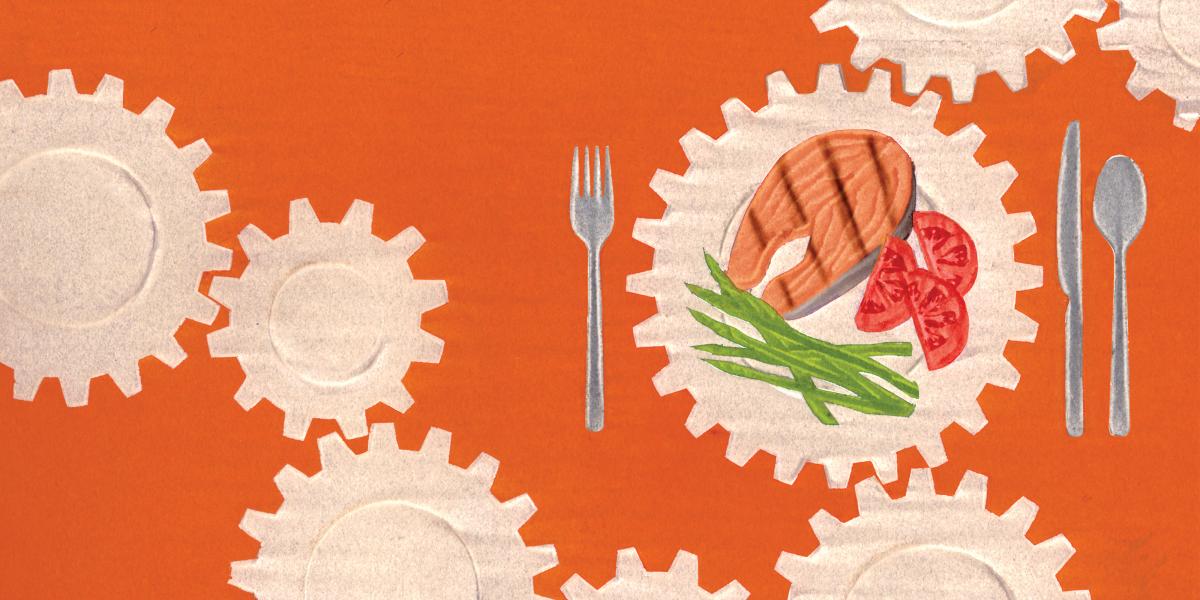Rethinking: Rebooting the Food System
Our fast-changing global food system desperately needs creative solutions.
The global food system is undergoing seismic shifts.
The traditional methods for preserving food system resilience and sustainability—informing policy and advocacy work—are still important, but they’re not enough. We need a new theory of change that includes market-shaping interventions, rigorous analysis of supply chains, technological solutions and interdisciplinary work.
What are we up against? The food system in the U.S. and around the world has never been so complex, so fluid and so connected with major challenges like climate change, antibiotic resistance, environmental health, the obesity epidemic and global trade. Consider the global ramifications of the “nutrition transition” in China. As meat consumption continues to rise there, China has reached its limits of arable land so it relies more and more on grain imports from the U.S. and Ukraine. To meet demand, Chinese companies have bought Smithfield Foods and Syngenta, major players in the world of livestock and genetically engineered crop production. At the same time, China wants to move 250 million people from rural to urban areas. What will be the impact of these changes on ecosystems and access to food in Shanghai—and Sioux City? We need to analyze the possible effects so we can anticipate both positive and negative outcomes and strategize accordingly.
Complex problems require creative solutions. Let me give you a couple of examples of the kind of solutions I’m talking about.
In 2008, I worked on a UNICEF project to improve the delivery of ready-to-use therapeutic foods, or RUTF, to severely malnourished children in the Horn of Africa. RUTF transformed treatment of the severely malnourished. Before RUTF, children had to be treated in hospitals: When the beds were full, children didn’t get treatment. RUTF made it possible for moms to treat their children at home. Great solution, but it wasn’t always reaching the children who needed it. We analyzed every point in the supply chain and found ways to improve delivery and avoid costly emergency shipments by air. Stockpiling RUTF at critical points made an invaluable product more accessible.
Another example: In 1998 when I worked for The Rockefeller Foundation, HIV/AIDS afflicted 25 million people in low- and middle-income countries. The lifesaving, three-drug cocktail cost $10,000 to $15,000 per person per year—a price that was far beyond the reach of millions of people. One of my Rockefeller grantees, an expert in intellectual property rights, began working with pharmaceutical companies. The result? Negotiations that led to a generic AIDS drug treatment at $350 a year—less than $1 a day. The lower drug prices spurred examination of the pharmaceutical value chain to re-engineer the way drugs move from bench to bedside. More than 15 years later, these market-shaping issues continue to reverberate in policy dialogues. Stepping outside of our public health box and delving into the world of an unfamiliar discipline enabled a game-changer.
It’s a valuable lesson for us all: Cutting across disciplinary borders can yield big solutions. By working with economists and other experts on trade issues, we can create major opportunities to improve food systems. We need to understand more about how food—and pathogens—crosses borders, why, and what the impacts of those transactions are. Research and policy work are important to be sure, but what might we achieve if we tackle the problem from a trade perspective?
We also need to look at innovative tech solutions that can change or shape sustainable agricultural practices and consumption practices. For example, a potential leap forward: a rapid diagnostic that could test people, animals and meat for antibiotic-resistant pathogens. If you bought chicken at Whole Foods and found it had antibiotic-resistant Salmonella, that would change the value chain immediately. Other innovations might help us adapt to climate change, conserve soil and water, or minimize pesticide use.
And as I learned with RUTF, closely examining supply and delivery chains can have outsized impacts. Currently a Johns Hopkins Center for a Livable Future team is working to reduce the 40 percent of food supply that is wasted in the U.S. each year.

I’ve recently taken the helm of the Center for a Livable Future. Bob Lawrence founded the Center 20 years ago and has left some very big shoes to fill. As I try to move the Center from success to even greater impact, I’m taking stock of opportunities for reforming the food system and drawing on my experience working within the U.S. government and in international, nongovernmental sectors. I’m seeking to pair what the Center has been doing successfully—solid research, policy and advocacy work—with ideas for market-shaping interventions that will come from rolling up our sleeves and doing more analysis, more research.
The future demands that we make the game-changing advances that will require big picture, cross-disciplinary approaches. We’ll need help from engineers, economists and experts from other disciplines.
For us to achieve a healthier, more resilient and more sustainable food system, we’ll need creativity, resourcefulness and bridges to other disciplines.
